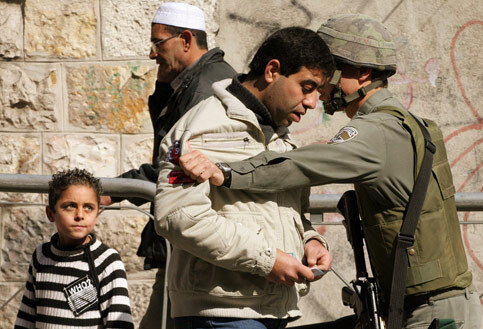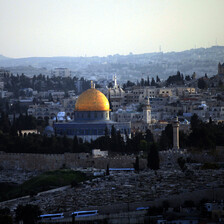The Electronic Intifada 15 May 2007

An Israeli soldier prevents a Palestinian Muslim worshipper from entering the Old City of Jerusalem, 9 February 2007. (Magnus Johansson/MaanImages)
With the celebration of Israel’s 59th year of independence comes the mourning of the 59th year of what the Palestinians call Al-Nakba — the disaster. Israel celebrated its Independence this week by “locking down” the Palestinians in their towns and villages through the total closure of all checkpoints encircling major Palestinian population centers.
This year, the Palestinians will remember their nearly six decades of dispossession by marking the expulsion of vast majority of the people; splitting up of families; and the creation of hundred’s of thousands of refugees, many of whom remain refugees today. They will remember the villages that no longer exist and the family farmlands that are now Israeli cities, shopping malls, forests, farms, and highways, places that Palestinians are not even allowed to visit. But those who remain in Palestine will also remember that they are still here, and they will swear that they will never again be forced to leave their lands and families. But this is a difficult oath to keep, not only because of IDF brutality, but also because of the structural, systematic violence of Israeli bureaucracy.
The sad truth is that while the Palestinians commemorate the Nakba of 1948, the disaster is ongoing up until today. Now, however, the oppression is subtler than the forced marches of the citizens of Ramla, the forced exodus of hundreds of thousands, or those who fled from violence or from the fear and confusion about what the Jewish militias were threatening or the Arab governments promising. It is a slow, forced exodus that is not exciting enough to warrant any airtime or column space. We are witnessing the slow but sure strangulation of Palestinian culture and existence in their homeland through Israeli bureaucratic policies and strategies. Palestinians are a people being squeezed to death, not only by a wall that cuts off farmers from their ancestral lands and splits families in two, but also by a system of paper, permits, proof, and permissions.
There are three “types” of Palestinian ID holders — Israeli citizens, Jerusalem residents, and West Bank/Gaza Palestinians. The last two categories of people are facing the most pressure. Unlike Palestinian ID holders who suffer hundreds of checkpoints everyday in the West Bank, holding a Jerusalem ID allows for a certain freedom of movement, both in Israel and in the West Bank (but not Gaza), and is thus a desired status to maintain.
However, Jerusalem Palestinians, who have lived in the holy city for generations, have to prove their existence in Jerusalem with paper; electric bills, the taxes they pay to the State of Israel, phone bills, etc. There is a caveat: If a family member is “outside” the designated Jerusalem municipality for five years, let’s say studying abroad, his or her residency is lost. In the past, if a visit for a month or more was made every six months, the length of time spent outside the Jerusalem area did not matter. As of last fall, though, this is no longer the case. No matter how often a visit is made during those five years, the residency is lost, even if the rest of the family remain Jerusalem residents. The same is true for Jerusalemites living in the West Bank; they must maintain a “proof of life in Jerusalem” to maintain the ID.
Another obstacle facing Jerusalemites is that the State of Israel determines the “area” considered Jerusalem. For example, many families who have been Jerusalemites for generations awoke one day and discovered that their town, which had “officially” been part of Jerusalem, was suddenly part of the West Bank because the “Separation Wall” now ran through the middle of it. The routing of the wall is determined by the State of Israel. Suddenly, family homes happened to be on the “wrong side” and many who could afford to do so had to rent additional homes or stay with other family members whose homes were on the “right side” of the wall in order to maintain their residency, not to mention the integrity of their families.
Jerusalemites who marry spouses from the West Bank have other hurdles to overcome. It is part of Palestinian and Arab culture to marry into a family of similar status or a member of the larger family. With the division and closure of many parts of historic Palestine, families are divided into the three aforementioned categories. Israeli citizens who want to marry someone from the West Bank usually face a choice not to marry, risk the spouse being arrested, or live in the West Bank. No citizenship or residency will be given to the spouse. For the last four years, it is illegal for Israeli citizens to go, let alone live, in the West Bank or Gaza.
But Jerusalemites who marry a Palestinian ID holder must carry their papers with them at all times as proof of their marital status. As well, their spouse must have an additional reason for being in Jerusalem, whether for schooling or employment, so many have an organization or company secure the required permit to “sleep” in Jerusalem for an extended period of time. They must prove they have a “valid” reason to be there in addition to their marriage. Palestinian ID holders must apply to the State of Israel, which then decides if they have permission to be in Jerusalem. The majority of these permits are good from 5 a.m. to 7 p.m. They must be out of Jerusalem by evening or risk arrest. A few lucky ones receive a permit from midnight to midnight. All permits for Israel, Jerusalem, the West Bank (for Gazans) and Gaza (for West Bankers and Jerusalemites) are only valid for three-month periods renewable, of course, by going through the whole process again.
Not only must the adults of Jerusalem prove their right to live, marry, and die there, but they must also prove that their children have the right to grow up in Jerusalem. All babies born to Jerusalem ID holders must be registered with the Israeli Ministry of the Interior so that they can be given a number that gives them permission to stay in Jerusalem. One young couple, celebrating the birth of their first child, waited the requisite one month before going to register the baby. As is the tradition, they live in the family home in Jerusalem. The utilities are in the name of the grandfather, although all pay their share.
When he made his first trip to the Ministry of the Interior, the young father was told that he had to prove his residency in Jerusalem with some type of utility bill. The tax receipt from the government of Israel verifying the payment of the “arnona tax”, which all Palestinian residents must pay, was not enough. He went to a lawyer with his father and grandfather and signed an affidavit that he paid utilities to his grandfather and went back to the Ministry. The second trip, the clerk had changed her mind and told him it was not enough. She inquired how the whole family could live together in the house and refused to register the child until he could show utilities papers in his own name. She told him that in order to register his child, he had to move out of the family house and get an apartment of his own with the rent and utilities in his name. After doing this, in six months or maybe a year, he should bring all the papers and try again. This child was born in a Jerusalem hospital to a family that had lived in Jerusalem for generations and he was being asked to give up his culture and tradition to make the child “legal”. One woman had been able to register four of her six children; both parents are Jerusalem ID holders with two children (under the age of 10) that are “illegally” living with their parents.
Another family was deported one-by-one from their family home they and their ancestors had lived in for 100 years because their Jerusalem residency visas had expired. They were refused renewal because they held a Jordanian or “foreign” passport, as many West Bank and Jerusalem Palestinians have since the period predating the Israeli occupation of the West Bank in 1967. Deportation also fractures families of West Bank Palestinians. There are too many stories like these that go untold or unnoticed. Jerusalem is quietly and methodically being divested of its Palestinian population.
The forced exodus of the Nakba continues, but at a pace that is too quiet for television cameras to capture, and too slow to provide even a catchy 20-second sound byte. When there are car bombs, mass exodus, and refugee camps being set up by the thousands, no one wants, or seems to know how, to cover a slow suffocation of a people and the elimination of their society and culture by means of paper, permits, proof, and permissions.
Julia Pitner is an American living in Occupied Ramallah
Related Links


